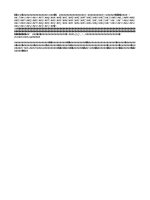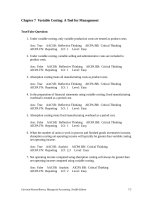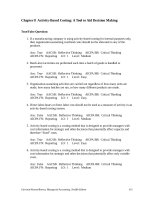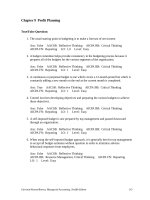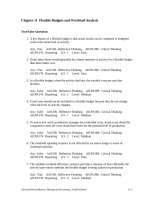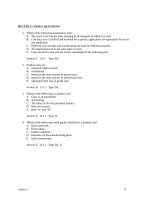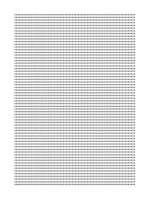Test bank managerial accounting by garrison 13e chapter 05
Bạn đang xem bản rút gọn của tài liệu. Xem và tải ngay bản đầy đủ của tài liệu tại đây (268.33 KB, 112 trang )
Chapter 5 Cost Behavior: Analysis and Use
True/False Questions
1. Within the relevant range, a change in activity results in a change in total variable cost
and the per unit fixed cost.
Ans: True AACSB: Reflective Thinking AICPA BB: Critical Thinking
AICPA FN: Reporting LO: 1 Level: Medium
2. The reluctance of managers to lay off employees when activity declines in the shortrun leads to an increase in the ratio of variable to fixed costs.
Ans: False AACSB: Reflective Thinking AICPA BB: Critical Thinking
AICPA FN: Reporting LO: 1 Level: Hard
3. A variable cost fluctuates in total as activity changes but remains constant on a per unit
basis over the relevant range.
Ans: True AACSB: Reflective Thinking AICPA BB: Critical Thinking
AICPA FN: Reporting LO: 1 Level: Easy
4. A cost that is classified as variable with respect to one measure of activity could be
classified as fixed with respect to a different measure of activity.
Ans: True AACSB: Reflective Thinking AICPA BB: Critical Thinking
AICPA FN: Reporting LO: 1 Level: Hard
5. Fixed costs remain constant in total, but vary inversely with changes in activity when
expressed on a per unit basis.
Ans: True AACSB: Reflective Thinking AICPA BB: Critical Thinking
AICPA FN: Reporting LO: 1 Level: Easy
6. Committed fixed costs have a short-term planning horizon--usually one year.
Ans: False AACSB: Reflective Thinking AICPA BB: Critical Thinking
AICPA FN: Reporting LO: 1 Level: Easy
7. The following costs are all examples of committed fixed costs: depreciation on
buildings, advertising, insurance, and management development and training.
Ans: False AACSB: Reflective Thinking AICPA BB: Critical Thinking
AICPA FN: Reporting LO: 1 Level: Medium
Garrison/Noreen/Brewer, Managerial Accounting, Twelfth Edition
5-5
Chapter 5 Cost Behavior: Analysis and Use
8. The time frame in which discretionary fixed costs are controllable is usually much
shorter than the time frame for committed fixed costs.
Ans: True AACSB: Reflective Thinking AICPA BB: Critical Thinking
AICPA FN: Reporting LO: 1 Level: Easy
9. The high-low method is generally more accurate than the least-squares regression
method in analyzing cost behavior.
Ans: False AACSB: Reflective Thinking AICPA BB: Critical Thinking
AICPA FN: Reporting LO: 3,5 Level: Easy
10. A major problem with the high-low method of cost estimation is that some data are
omitted from the analysis.
Ans: True AACSB: Reflective Thinking AICPA BB: Critical Thinking
AICPA FN: Reporting LO: 3 Level: Easy
11. The high and low points used in the high-low method tend to be unusual and therefore
the cost formula may not accurately represent all of the data.
Ans: True AACSB: Reflective Thinking AICPA BB: Critical Thinking
AICPA FN: Reporting LO: 3 Level: Easy
12. Contribution margin and gross margin mean the same thing.
Ans: False AACSB: Reflective Thinking AICPA BB: Critical Thinking
AICPA FN: Reporting, Measurement LO: 4 Level: Medium
13. Contribution margin equals revenue minus all variable costs.
Ans: True AACSB: Reflective Thinking AICPA BB: Critical Thinking
AICPA FN: Reporting LO: 4 Level: Easy
14. The traditional income statement organizes costs on the basis of cost behavior.
Ans: False AACSB: Reflective Thinking AICPA BB: Critical Thinking
AICPA FN: Measurement LO: 4 Level: Easy
5-6
Garrison/Noreen/Brewer, Managerial Accounting, Twelfth Edition
Chapter 5 Cost Behavior: Analysis and Use
15. It is necessary to break mixed costs into their variable and fixed cost components in
order to construct an income statement using the contribution approach.
Ans: True AACSB: Reflective Thinking AICPA BB: Critical Thinking
AICPA FN: Reporting LO: 4 Level: Easy
Multiple Choice Questions
16. A is a fixed cost; B is a variable cost. During the current year the level of activity has
decreased but is still within the relevant range. We would expect that:
A) The cost per unit of A has remained unchanged.
B) The cost per unit of B has decreased.
C) The cost per unit of A has decreased.
D) The cost per unit of B has remained unchanged.
Ans: D AACSB: Analytic AICPA BB: Critical Thinking
AICPA FN: Reporting LO: 1 Level: Medium
17. Which costs will change with an increase in activity within the relevant range?
A) Unit fixed cost and total fixed cost
B) Unit variable cost and total variable cost
C) Unit fixed cost and total variable cost
D) Unit fixed cost and unit variable cost
Ans: C AACSB: Analytic AICPA BB: Critical Thinking
AICPA FN: Reporting LO: 1 Level: Medium
18. Salaries of accounts receivable clerks when one clerical worker is needed for every
750 accounts receivable is an example of a:
A) fixed cost
B) step-variable cost
C) mixed cost
D) curvilinear cost
Ans: B AACSB: Analytic AICPA BB: Critical Thinking
AICPA FN: Reporting LO: 1 Level: Medium
Garrison/Noreen/Brewer, Managerial Accounting, Twelfth Edition
5-7
Chapter 5 Cost Behavior: Analysis and Use
19. Limousine Conversion Company purchases ordinary Cadillacs, cuts them in half, and
then adds a middle section to the vehicles to create stretch limousines. With respect to
the number of cars converted, the cost of the Cadillacs purchased for conversion by
Limousine Conversion Company would best be described as a:
A) fixed cost
B) mixed cost
C) step-variable cost
D) variable cost
Ans: D AACSB: Analytic AICPA BB: Critical Thinking
AICPA FN: Reporting LO: 1 Level: Easy
20. For an automobile manufacturer, the cost of a driver's side air bag purchased from a
supplier and installed in every automobile would best be described as a:
A) fixed cost.
B) mixed cost.
C) step-variable cost.
D) variable cost.
Ans: D AACSB: Analytic AICPA BB: Critical Thinking
AICPA FN: Reporting LO: 1 Level: Easy
21. With respect to a fixed cost, an increase in the activity level within the relevant range
results in:
A) an increase in fixed cost per unit.
B) a proportionate increase in total fixed costs.
C) an unchanged fixed cost per unit.
D) a decrease in fixed cost per unit.
Ans: D AACSB: Analytic AICPA BB: Critical Thinking
AICPA FN: Reporting LO: 1 Level: Easy
22. In the standard cost formula Y = a + bX, what does the “Y” represent?
A) total cost
B) total fixed cost
C) total variable cost
D) variable cost per unit
Ans: A AACSB: Reflective Thinking AICPA BB: Critical Thinking
AICPA FN: Reporting LO: 1 Level: Easy
5-8
Garrison/Noreen/Brewer, Managerial Accounting, Twelfth Edition
Chapter 5 Cost Behavior: Analysis and Use
23. In the standard cost formula Y = a + bX, what does the “a” represent?
A) total cost
B) total fixed cost
C) total variable cost
D) variable cost per unit
Ans: B AACSB: Reflective Thinking AICPA BB: Critical Thinking
AICPA FN: Reporting LO: 1 Level: Easy
24. In the standard cost formula Y = a + bX, what does the “b” represent?
A) total cost
B) total fixed cost
C) total variable cost
D) variable cost per unit
Ans: D AACSB: Reflective Thinking AICPA BB: Critical Thinking
AICPA FN: Reporting LO: 1 Level: Medium
25. In the standard cost formula Y = a + bX, what does the “X” represent?
A) total cost
B) total fixed cost
C) units of activity
D) variable cost per unit
Ans: C AACSB: Reflective Thinking AICPA BB: Critical Thinking
AICPA FN: Reporting LO: 1 Level: Easy
26. Which of the following would usually be considered a discretionary fixed cost for a
soft drink bottling company?
A) the cost of advertising its products
B) the cost of fire insurance on its factory building
C) depreciation on its manufacturing equipment
D) both a and b above
Ans: A AACSB: Reflective Thinking AICPA BB: Critical Thinking
AICPA FN: Reporting LO: 1 Level: Medium
Garrison/Noreen/Brewer, Managerial Accounting, Twelfth Edition
5-9
Chapter 5 Cost Behavior: Analysis and Use
27. Which of the following is a weakness of the quick-and-dirty scattergraph method of
analyzing mixed cost?
A) It is impossible to determine variable cost per unit.
B) Only two data points are used and the rest are ignored in drawing the
scattergraph.
C) Different people will have different answers even though they are analyzing the
same set of data.
D) Both B and C above
Ans: C AACSB: Reflective Thinking AICPA BB: Critical Thinking
AICPA FN: Reporting LO: 2 Level: Easy
28. Which of the following statements is true when referring to the high-low method of
cost analysis?
A) The high-low method has no major weaknesses.
B) The high-low method is very hard to apply.
C) In essence, the high-low method draws a straight line through two data points.
D) None of the above is true.
Ans: C AACSB: Reflective Thinking AICPA BB: Critical Thinking
AICPA FN: Reporting LO: 3 Level: Easy
29. Contribution margin is computed as sales revenue minus:
A) fixed expenses
B) variable expenses
C) cost of goods sold
D) cost of goods manufactured
Ans: B AACSB: Reflective Thinking AICPA BB: Critical Thinking
AICPA FN: Reporting, Measurement LO: 4 Level: Easy
5-10
Garrison/Noreen/Brewer, Managerial Accounting, Twelfth Edition
Chapter 5 Cost Behavior: Analysis and Use
30. Which of the following approaches to preparing an income statement calculates gross
margin?
A)
B)
C)
D)
Traditional Contribution
Approach
Approach
Yes
Yes
Yes
No
No
Yes
No
No
Ans: B AACSB: Reflective Thinking AICPA BB: Critical Thinking
AICPA FN: Measurement LO: 4 Level: Medium
31. The least-squares regression method:
A) fits a regression line by minimizing the sum of the squared errors from the
regression line.
B) is generally less accurate than the scattergraph method.
C) can be used only if the fixed cost element is larger than the variable cost
element.
D) is the only method acceptable under generally accepted accounting principles.
Ans: A AACSB: Reflective Thinking AICPA BB: Critical Thinking
AICPA FN: Reporting LO: 5 Level: Medium
32. Multiple regression analysis is used when:
A) more than one cost category must be analyzed.
B) when more than one factor causes variation in a cost.
C) the high-low method cannot be used because there is only one observation.
D) all of the points on a scattergraph fall exactly on a regression line.
Ans: B AACSB: Reflective Thinking AICPA BB: Critical Thinking
AICPA FN: Reporting LO: 5 Level: Medium
Garrison/Noreen/Brewer, Managerial Accounting, Twelfth Edition
5-11
Chapter 5 Cost Behavior: Analysis and Use
33. Iacono Corporation is a wholesaler that sells a single product. Management has
provided the following cost data for two levels of monthly sales volume. The company
sells the product for $127.20 per unit.
Sales volume (units)...................................
5,000
6,000
Cost of sales............................................... $419,000 $502,800
Selling and administrative costs................. $186,500 $202,200
The best estimate of the total contribution margin when 5,300 units are sold is:
A) $230,020
B) $51,410
C) $146,810
D) $32,330
Ans: C AACSB: Analytic AICPA BB: Critical Thinking
AICPA FN: Reporting LO: 1,3,4 Level: Hard
Solution:
Variable component of cost of goods sold:
Variable cost = Change in costs/Change in units
Variable cost = ($502,800 − $419,000)/(6,000 − 5,000)
Variable cost = $83.80 per unit
Variable component of selling and administrative expenses:
Variable cost = Change in costs/Change in units
Variable cost = ($202,200 − $186,500)/(6,000 − 5,000)
Variable cost = $15.70 per unit
Sales revenue ($127.20 × 5,300).........................
$674,160
Variable expenses:
Variable cost of goods sold ($83.80 × 5,300)... $444,140
Variable selling and administrative expense
83,210
527,350
($15.70 × 5,300)...........................................
Contribution margin............................................
$ 146,810
5-12
Garrison/Noreen/Brewer, Managerial Accounting, Twelfth Edition
Chapter 5 Cost Behavior: Analysis and Use
34. Utility costs at Service, Inc. are a mixture of fixed and variable components. Records
indicate that utility costs are an average of $0.40 per hour at an activity level of 9,000
machine hours and $0.25 per hour at an activity level of 18,000 machine hours.
Assuming that this activity is within the relevant range, what is the expected total
utility cost if the company works 13,000 machine hours?
A) $4,225
B) $5,200
C) $4,000
D) $3,250
Ans: C AACSB: Analytic AICPA BB: Critical Thinking
AICPA FN: Reporting LO: 1,3 Level: Hard
Solution:
MachineHours
High activity level...... 18,000
Low activity level...... 9,000
Average
Cost per
Hour
$0.25
$0.40
Total Utility Cost
(machine-hours ×
average cost per hour)
$4,500
$3,600
Variable cost = Change in cost ÷ Change in activity
= ($4,500 − $3,600) ÷ (18,000 – 9,000) = $0.10
Fixed cost element = Total cost − Variable cost element
= $4,500 − ($0.10 × 18,000) = $2,700
Therefore, the cost formula for total utility cost is $2,700 per period plus $0.10 per
machine-hour, or Y = $2,700 + $0.10X.
At an activity level of 13,000 machine-hours, total cost is estimated to be:
Y = $2,700 + ($0.10 × 13,000) = $4,000
Garrison/Noreen/Brewer, Managerial Accounting, Twelfth Edition
5-13
Chapter 5 Cost Behavior: Analysis and Use
35. Clerical costs in the billing department of Craig Company are a mixture of variable
and fixed components. Records indicate that average unit processing costs are $0.50
per account processed at an activity level of 32,000 accounts. When only 22,000
accounts are processed, the total cost of processing is $12,500. Assuming that this
activity is within the relevant range, at a budgeted level of 25,000 accounts:
A) processing costs are expected to total $8,750.
B) fixed processing costs are expected to be $10,400.
C) the variable processing costs are expected to be $0.35 per account processed.
D) processing costs are expected to total $14,975.
Ans: C AACSB: Analytic AICPA BB: Critical Thinking
AICPA FN: Reporting LO: 1,3 Level: Hard
Solution:
Accounts
High activity level...... 32,000
Low activity level...... 22,000
*Given
Average
Cost per
Account
Processed
$0.50
Total Utility Cost
(accounts × average
cost per account
processed)
$16,000
$12,500*
Variable cost = Change in cost ÷ Change in activity
= ($16,000 − $12,500) ÷ (32,000 – 22,000) = $0.35
Fixed cost element = Total cost − Variable cost element
= $16,000 − ($0.35 × 32,000) = $4,800
Therefore, the cost formula for total utility cost is $4,800 per period plus $0.35 per
account processed, or Y = $4,800 + $0.35X.
At an activity level of 25,000 accounts, total cost is estimated to be:
Y = $4,800 + ($0.35 × 25,000) = $13,550
5-14
Garrison/Noreen/Brewer, Managerial Accounting, Twelfth Edition
Chapter 5 Cost Behavior: Analysis and Use
36. Shipping cost at Junk Food Imports is a mixed cost with variable and fixed
components. Past records indicate total shipping cost was $18,000 for 16,000 pounds
shipped and $22,500 for 22,000 pounds shipped. Assuming that this activity is within
the relevant range, if the company plans to ship 18,000 pounds next month, the
expected shipping cost is:
A) $18,500
B) $20,400
C) $19,500
D) $24,000
Ans: C AACSB: Analytic AICPA BB: Critical Thinking
AICPA FN: Reporting LO: 1,3 Level: Medium
Solution:
High activity level......
Low activity level......
Pounds Shipped
22,000
16,000
Shipping
Cost
$22,500
$18,000
Variable cost = Change in cost ÷ Change in activity
= ($22,500 − $18,000) ÷ (22,000 − 16,000) = $0.75
Fixed cost element = Total cost − Variable cost element
= $22,500 − ($0.75 × 22,000) = $6,000
Therefore, the cost formula for total shipping cost is $6,000 per period plus $0.75 per
pound shipped, or Y = $6,000 + $0.75X.
At an activity level of 18,000 pounds shipped, total cost is estimated to be:
Y = $6,000 + ($0.75 × 18,000) = $19,500
Garrison/Noreen/Brewer, Managerial Accounting, Twelfth Edition
5-15
Chapter 5 Cost Behavior: Analysis and Use
37. Larson Brothers, Inc., used the high-low method to derive its cost formula for
electrical power cost. According to the cost formula, the variable cost per unit of
activity is $3 per machine-hour. Total electrical power cost at the high level of activity
was $7,600 and at the low level of activity was $7,300. If the high level of activity was
1,200 machine hours, then the low level of activity was:
A) 800 machine hours
B) 900 machine hours
C) 1,000 machine hours
D) 1,100 machine hours
Ans: D AACSB: Analytic AICPA BB: Critical Thinking
AICPA FN: Reporting LO: 1,3 Level: Hard
Solution:
Variable cost = Change in cost ÷ Change in activity
= ($7,600 − $7,300) ÷ (1,200 − X) = $3, where X = low level of activity
=> $300 ÷ (1,200 – X) = $3
=> $300 = $3 × (1,200 – X)
=> $100 = $1,200 – X
=> X = $1,100
5-16
Garrison/Noreen/Brewer, Managerial Accounting, Twelfth Edition
Chapter 5 Cost Behavior: Analysis and Use
38. The following production and average cost data for a month's operations have been
supplied by a company that produces a single product.
Production volume.........................
1,000 units
2,000 units
Direct materials.............................. $4.00 per unit $4.00 per unit
Direct labor.................................... $3.50 per unit $3.50 per unit
Manufacturing overhead................ $10.00 per unit $6.20 per unit
The total fixed manufacturing cost and variable manufacturing cost per unit are as
follows:
A) $3,600; $7.50
B) $3,600; $9.90
C) $7,600; $7.50
D) $7,600; $9.90
Ans: D AACSB: Analytic AICPA BB: Critical Thinking
AICPA FN: Reporting LO: 1,3 Level: Hard Source: CIMA, adapted
Solution:
First, calculate the variable manufacturing cost per unit:
Production
Volume
(Units)
High activity level...... 2,000
Low activity level...... 1,000
Average
Cost per
Unit
$6.20
$10.00
Total Manufacturing
Overhead Cost (units
× average cost per
unit)
$12,400
$10,000
Variable manufacturing overhead cost = Change in cost ÷ Change in activity
= ($12,400 − $10,000) ÷ (2,000 – 1,000) = $2.40
Fixed cost element of manufacturing overhead = Total cost − Variable cost element
= $12,400 − ($2.40 × 2,000) = $7,600
Total variable cost per unit = Direct material + Direct labor + Variable manufacturing
overhead = $4.00 + $3.50 + $2.40 = $9.90
There are no fixed direct materials or direct labor, so the total fixed costs would be
equal to the fixed cost portion of manufacturing overhead, or $7,600.
Garrison/Noreen/Brewer, Managerial Accounting, Twelfth Edition
5-17
Chapter 5 Cost Behavior: Analysis and Use
39. Anderst Corporation has provided the following production and average cost data for
two levels of monthly production volume. The company produces a single product.
Production volume.........................
2,000 units
4,000 units
Direct materials.............................. $50.20 per unit $50.20 per unit
Direct labor.................................... $45.10 per unit $45.10 per unit
Manufacturing overhead................ $100.90 per unit $58.30 per unit
The best estimate of the total monthly fixed manufacturing cost is:
A) $201,800
B) $233,200
C) $170,400
D) $392,400
Ans: C AACSB: Analytic AICPA BB: Critical Thinking
AICPA FN: Reporting LO: 1,3 Level: Hard
Solution:
First, calculate the variable manufacturing cost per unit:
Production
Volume
(Units)
High activity level...... 4,000
Low activity level...... 2,000
Average
Cost per
Unit
$58.30
$100.90
Total Manufacturing
Overhead Cost (units
× average cost per
unit)
$233,200
$201,800
Variable manufacturing overhead cost = Change in cost ÷ Change in activity
= ($233,200 − $201,800) ÷ (4,000 – 2,000) = $15.70
Fixed cost element of manufacturing overhead = Total cost − Variable cost element
= $233,200 − ($15.70 × 4,000) = $170,400
5-18
Garrison/Noreen/Brewer, Managerial Accounting, Twelfth Edition
Chapter 5 Cost Behavior: Analysis and Use
40. Bakeman Corporation has provided the following production and average cost data for
two levels of monthly production volume. The company produces a single product.
Production volume.........................
2,000 units
3,000 units
Direct materials.............................. $36.10 per unit $36.10 per unit
Direct labor.................................... $48.00 per unit $48.00 per unit
Manufacturing overhead................ $51.00 per unit $40.90 per unit
The best estimate of the total variable manufacturing cost per unit is:
A) $104.80
B) $36.10
C) $20.70
D) $84.10
Ans: A AACSB: Analytic AICPA BB: Critical Thinking
AICPA FN: Reporting LO: 1,3 Level: Hard
Solution:
To calculate the variable manufacturing cost per unit:
Production
Volume
(Units)
High activity level...... 3,000
Low activity level...... 2,000
Average
Cost per
Unit
$40.90
$51.00
Total Manufacturing
Overhead Cost
(units × average cost
per unit)
$122,700
$102,000
Variable manufacturing overhead cost = Change in cost ÷ Change in activity
= ($122,700 − $102,000) ÷ (3,000 – 2,000) = $20.70
Total variable manufacturing cost per unit
= Direct materials + Direct labor + Manufacturing overhead
= $36.10 + $48.00 + $20.70 = $104.80
Garrison/Noreen/Brewer, Managerial Accounting, Twelfth Edition
5-19
Chapter 5 Cost Behavior: Analysis and Use
41. Carcia Corporation has provided the following production and average cost data for
two levels of monthly production volume. The company produces a single product.
Production volume.........................
6,000 units
7,000 units
Direct materials.............................. $89.40 per unit $89.40 per unit
Direct labor.................................... $11.20 per unit $11.20 per unit
Manufacturing overhead................ $107.70 per unit $95.70 per unit
The best estimate of the total cost to manufacture 6,300 units is closest to:
A) $1,274,490
B) $1,287,090
C) $1,312,290
D) $1,236,690
Ans: B AACSB: Analytic AICPA BB: Critical Thinking
AICPA FN: Reporting LO: 1,3 Level: Hard
Solution:
To calculate the variable manufacturing cost per unit:
Production
Volume
(Units)
High activity level...... 7,000
Low activity level...... 6,000
Average
Cost per
Unit
$95.70
$107.70
Total Manufacturing
Overhead Cost (units
× average cost per
unit)
$669,900
$646,200
Variable manufacturing overhead cost
= Change in cost ÷ Change in activity
= ($669,900 − $646,200) ÷ (7,000 – 6,000) = $23.70
Fixed cost element of manufacturing overhead
= Total cost − Variable cost element
= $669,900 − ($23.70 × 7,000) = $504,000
Direct materials...................................
Direct labor..........................................
Variable manufacturing overhead........
Fixed manufacturing overhead............
Total cost to manufacture 6,300 units
5-20
Per Unit
Cost
$89.40
$11.20
$23.70
Number
of Units
6,300
6,300
6,300
Total Cost
$ 563,220
70,560
149,310
504,000
$1,287,090
Garrison/Noreen/Brewer, Managerial Accounting, Twelfth Edition
Chapter 5 Cost Behavior: Analysis and Use
42. Daar Corporation has provided the following production and total cost data for two
levels of monthly production volume. The company produces a single product.
Production volume......................... 2,000 units 3,000 units
Direct materials..............................
$188,400
$282,600
Direct labor....................................
$91,800
$137,700
Manufacturing overhead................
$110,400
$127,800
The best estimate of the total monthly fixed manufacturing cost is:
A) $75,600
B) $390,600
C) $469,350
D) $548,100
Ans: A AACSB: Analytic AICPA BB: Critical Thinking
AICPA FN: Reporting LO: 1,3 Level: Medium
Solution:
To calculate the variable manufacturing cost per unit:
Production
Volume
(Units)
High activity level...... 3,000
Low activity level...... 2,000
Total Manufacturing
Overhead Cost
$127,800
$110,400
Variable manufacturing overhead cost
= Change in cost ÷ Change in activity
= ($127,800 − $110,400) ÷ (3,000 – 2,000) = $17.40
Fixed cost element of manufacturing overhead
= Total cost − Variable cost element
= $127,800 − ($17.40 × 3,000) = $75,600
Garrison/Noreen/Brewer, Managerial Accounting, Twelfth Edition
5-21
Chapter 5 Cost Behavior: Analysis and Use
43. Edde Corporation has provided the following production and total cost data for two
levels of monthly production volume. The company produces a single product.
Production volume......................... 4,000 units 5,000 units
Direct materials..............................
$291,200
$364,000
Direct labor....................................
$219,600
$274,500
Manufacturing overhead................
$320,400
$343,000
The best estimate of the total variable manufacturing cost per unit is:
A) $127.70
B) $150.30
C) $22.60
D) $72.80
Ans: B AACSB: Analytic AICPA BB: Critical Thinking
AICPA FN: Reporting LO: 1,3 Level: Medium
Solution:
Direct material cost per unit = $291,200 ÷ 4,000 = $72.80
(Alternatively, direct material cost per unit = $364,000 ÷ 5,000 = $72.80)
Direct labor cost per unit = $219,600 ÷ 4,000 = $54.90
(Alternatively, direct labor cost per unit = $274,500 ÷ 5,000 = $54.90)
Variable manufacturing overhead cost = Change in cost ÷ Change in activity
= ($343,000 − $320,400) ÷ (5,000 – 4,000) = $22.60
Total variable manufacturing cost per unit = $72.80 + $54.90 + $22.60 = $150.30
5-22
Garrison/Noreen/Brewer, Managerial Accounting, Twelfth Edition
Chapter 5 Cost Behavior: Analysis and Use
44. Farah Corporation has provided the following production and total cost data for two
levels of monthly production volume. The company produces a single product.
Production volume......................... 2,000 units 3,000 units
Direct materials..............................
$146,200
$219,300
Direct labor....................................
$37,200
$55,800
Manufacturing overhead................
$146,600
$158,100
The best estimate of the total cost to manufacture 2,300 units is closest to:
A) $332,120
B) $379,500
C) $355,810
D) $360,960
Ans: D AACSB: Analytic AICPA BB: Critical Thinking
AICPA FN: Reporting LO: 1,3 Level: Medium
Solution:
To calculate the variable manufacturing cost per unit:
Production
Volume
(Units)
High activity level...... 3,000
Low activity level...... 2,000
Total Manufacturing
Overhead Cost
$158,100
$146,600
Variable manufacturing overhead cost
= Change in cost ÷ Change in activity
= ($158,100 − $146,600) ÷ (3,000 – 2,000) = $11.50
Fixed cost element of manufacturing overhead
= Total cost − Variable cost element
= $158,100 − ($11.50 × 3,000) = $123,600
Garrison/Noreen/Brewer, Managerial Accounting, Twelfth Edition
5-23
Chapter 5 Cost Behavior: Analysis and Use
Per Unit
Cost
Direct materials................................... $73.10*
Direct labor.......................................... $18.60**
Variable manufacturing overhead........ $11.50
Fixed manufacturing overhead............
Total cost to manufacture 2,300 units
Number
of Units
2,300
2,300
2,300
Total Cost
$168,130
42,780
26,450
123,600
$360,960
*$219,300 ÷ 3,000 units = $73.10 per unit
**$55,800 ÷ 3,000 units = $18.60 per unit
45. Gamad Corporation is a wholesaler that sells a single product. Management has
provided the following cost data for two levels of monthly sales volume. The company
sells the product for $131.00 per unit.
Sales volume (units).............................
4,000
5,000
Cost of sales......................................... $262,800 $328,500
Selling and administrative costs........... $230,400 $244,500
The best estimate of the total monthly fixed cost is:
A) $174,000
B) $533,100
C) $493,200
D) $573,000
Ans: A AACSB: Analytic AICPA BB: Critical Thinking
AICPA FN: Reporting LO: 1,3 Level: Medium
5-24
Garrison/Noreen/Brewer, Managerial Accounting, Twelfth Edition
Chapter 5 Cost Behavior: Analysis and Use
Solution:
Variable component of cost of goods sold:
Variable cost = Change in costs/Change in units
Variable cost = ($328,500 − $262,800)/(5,000 − 4,000)
Variable cost = $65.70
Fixed cost:
High volume: $328,500 − $65.70 × 5,000 = $0
Low volume: $262,800 − $65.70 × 4,000 = $0
Variable component of selling and administrative expenses:
Variable cost = Change in costs/Change in units
Variable cost = ($244,500 − $230,400)/(5,000 − 4,000)
Variable cost = $14.10 per unit
Fixed cost:
High volume: $244,500 − $14.10 × 5,000 = $174,000
Low volume: $230,400 − $14.10 × 4,000 = $174,000
Total variable cost per unit:
$65.70 + $14.10 = $79.80
Total fixed cost:
$0 + $174,000 = $174,000
Garrison/Noreen/Brewer, Managerial Accounting, Twelfth Edition
5-25
Chapter 5 Cost Behavior: Analysis and Use
46. Harada Corporation is a wholesaler that sells a single product. Management has
provided the following cost data for two levels of monthly sales volume. The company
sells the product for $88.70 per unit.
Sales volume (units).............................
4,000
5,000
Cost of sales......................................... $273,600 $342,000
Selling and administrative costs........... $56,800 $68,000
The best estimate of the total variable cost per unit is:
A) $68.40
B) $79.60
C) $82.60
D) $82.00
Ans: B AACSB: Analytic AICPA BB: Critical Thinking
AICPA FN: Reporting LO: 1,3 Level: Medium
Solution:
Variable component of cost of goods sold:
Variable cost = Change in costs/Change in units
Variable cost = ($342,000 − $273,600)/(5,000 − 4,000)
Variable cost = $68.40 per unit
Fixed cost:
High volume: $342,000 − $68.40 × 5,000 = $0
Low volume: $273,600 − $68.40 × 4,000 = $0
Variable component of selling and administrative expenses:
Variable cost = Change in costs/Change in units
Variable cost = ($68,000 − $56,800)/(5,000 − 4,000)
Variable cost = $11.20
Fixed cost:
High volume: $68,000 − $11.20 × 5,000 = $12,000
Low volume: $56,800 − $11.20 × 4,000 = $12,000
Total variable cost per unit:
$68.40 + $11.20 = $79.60
Total fixed cost:
$0 + $12,000 = $12,000
5-26
Garrison/Noreen/Brewer, Managerial Accounting, Twelfth Edition
Chapter 5 Cost Behavior: Analysis and Use
47. A company produces a single product. The following volume and average cost data for
two accounting periods have been provided by management:
Number of units.............................
Direct materials..............................
Direct labor....................................
Manufacturing overhead................
Other overhead...............................
500
800
$2.00 $2.00
$1.50 $1.50
$2.50 $1.75
$1.00 $0.625
The best estimate for the cost formula for the total cost of producing and selling the
product (where X is the number of units produced and sold in a period) is:
A) $1,000 + $1.125 X
B) $1,000 + $3.50 X
C) $1,500 + $3.50 X
D) $1,500 + $4.00 X
Ans: D AACSB: Analytic AICPA BB: Critical Thinking
AICPA FN: Reporting LO: 1,3 Level: Hard Source: CIMA, adapted
Garrison/Noreen/Brewer, Managerial Accounting, Twelfth Edition
5-27
Chapter 5 Cost Behavior: Analysis and Use
Solution:
Variable component of manufacturing overhead:
Variable cost = Change in costs/Change in units
Variable cost = ($1,400* − $1,250**)/(800 − 500)
Variable cost = $0.50
*$1.75 × 800 = $1,400
**$2.50 × 500 = $1,250
Fixed cost:
High volume: $1,400 − $0.50 × 800 = $1,000
Low volume: $1,250 − $0.50 × 500 = $1,000
Variable component of other overhead:
Variable cost = Change in costs/Change in units
Variable cost = ($500* − $500**)/(800 − 500)
Variable cost = $0
*$0.625 × 800 = $500
**$1.00 × 500 = $500
Fixed cost:
High volume: $500 − $0 × 800 = $500
Low volume: $500 − $0 × 500 = $500
Total variable cost per unit (includes direct material, direct labor, variable
manufacturing overhead, and variable other overhead):
$2.00 + $1.50 + $0.50 + $0 = $4.00
Total fixed cost:
$1,000 + $500 = $1,500
5-28
Garrison/Noreen/Brewer, Managerial Accounting, Twelfth Edition
Chapter 5 Cost Behavior: Analysis and Use
48. The employees at Mobile Sun Lotion Company roam the beaches with a tank of
premium suntan lotion strapped on their backs. For a $2 charge, the employees will
spray sunbathers with suntan lotion. Last year, Mobile sprayed 250,000 customers and
incurred the following costs:
Total variable costs............. $175,000
Total fixed costs.................
50,000
Total costs.......................... $225,000
Assuming that this activity is within the relevant range, what would Mobile's total
contribution margin have been last year if only 240,000 customers were sprayed?
A) $255,000
B) $262,000
C) $305,000
D) $312,000
Ans: D AACSB: Analytic AICPA BB: Critical Thinking
AICPA FN: Reporting LO: 1,4 Level: Medium
Solution:
Variable cost per unit: $175,000 ÷ 250,000 customers = $0.70 per customer
Sales ($2 × 240,000)........................................... $480,000
Variable costs ($0.70 × 240,000)........................
168,000
Contribution margin........................................... $312,000
Garrison/Noreen/Brewer, Managerial Accounting, Twelfth Edition
5-29
